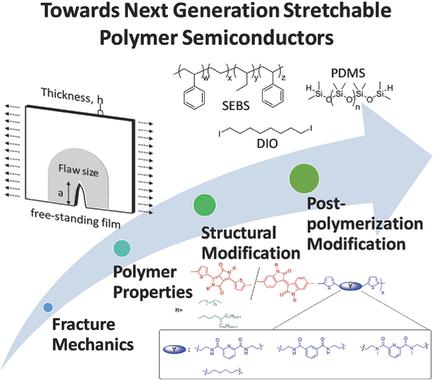当前位置:
X-MOL 学术
›
Adv. Electron. Mater.
›
论文详情
Our official English website, www.x-mol.net, welcomes your feedback! (Note: you will need to create a separate account there.)
Stretchable Polymer Semiconductors for Plastic Electronics
Advanced Electronic Materials ( IF 6.2 ) Pub Date : 2018-01-02 , DOI: 10.1002/aelm.201700429 Ging-Ji Nathan Wang 1 , Andrea Gasperini 1 , Zhenan Bao 1
Advanced Electronic Materials ( IF 6.2 ) Pub Date : 2018-01-02 , DOI: 10.1002/aelm.201700429 Ging-Ji Nathan Wang 1 , Andrea Gasperini 1 , Zhenan Bao 1
Affiliation

|
Conjugated polymers have evolved significantly in the past decade and have proven to be more than poorly conducting plastics. Instead, improved understanding has resulted in respectable charge‐carrier mobilities and power‐conversion efficiencies achieved by various donor‐acceptor‐type semiconducting polymers. However, their advantages in mechanical flexibility and deformability seem to have conflicting molecular design requirements from those for high charge‐carrier transporting properties. It is therefore a challenge to enhance the mechanical compliance of semiconducting polymers suitable for stretchable device applications. This progress report starts with a brief introduction to fracture mechanics and mechanical characterization techniques for thin polymer films, in order to consider the limitations and rationalization of current definition and parameters for stretchability. It then surveys different strategies that can be applied to improve the mechanical robustness and stretchability of polymer semiconductors, in particular focusing on molecular design aspects such as molecular weight and regioregularity, structural modifications in the polymer backbone and side chain, and postpolymerization modifications including blending and cross‐linking. Finally, directions for future development of next‐generation stretchable conjugated polymers are indicated.
中文翻译:

用于塑料电子的可拉伸聚合物半导体
在过去的十年中,共轭聚合物已经有了长足的发展,并且已证明其导电性不仅仅限于塑料。取而代之的是,对各种供体-受体-型半导体聚合物的了解使人们对电荷-载流子的迁移率和功率转换效率产生了可观的认识。然而,它们在机械柔韧性和可变形性方面的优势似乎与高载流子传输性质的分子设计要求相矛盾。因此,提高适用于可拉伸装置应用的半导体聚合物的机械柔韧性是一个挑战。此进度报告首先简要介绍了聚合物薄膜的断裂力学和力学表征技术,为了考虑当前定义和参数的可拉伸性的局限性和合理性。然后,它研究了可用于改善聚合物半导体的机械强度和拉伸性的不同策略,特别是侧重于分子设计方面,例如分子量和区域规则性,聚合物主链和侧链的结构改性以及包括共混和聚合的后聚合改性。交叉链接。最后,指出了下一代可拉伸共轭聚合物的未来发展方向。特别关注分子设计方面,例如分子量和区域规则性,聚合物主链和侧链的结构修饰以及包括共混和交联在内的后聚合修饰。最后,指出了下一代可拉伸共轭聚合物的未来发展方向。特别关注分子设计方面,例如分子量和区域规则性,聚合物主链和侧链的结构修饰以及聚合后的修饰(包括共混和交联)。最后,指出了下一代可拉伸共轭聚合物的未来发展方向。
更新日期:2018-01-02
中文翻译:

用于塑料电子的可拉伸聚合物半导体
在过去的十年中,共轭聚合物已经有了长足的发展,并且已证明其导电性不仅仅限于塑料。取而代之的是,对各种供体-受体-型半导体聚合物的了解使人们对电荷-载流子的迁移率和功率转换效率产生了可观的认识。然而,它们在机械柔韧性和可变形性方面的优势似乎与高载流子传输性质的分子设计要求相矛盾。因此,提高适用于可拉伸装置应用的半导体聚合物的机械柔韧性是一个挑战。此进度报告首先简要介绍了聚合物薄膜的断裂力学和力学表征技术,为了考虑当前定义和参数的可拉伸性的局限性和合理性。然后,它研究了可用于改善聚合物半导体的机械强度和拉伸性的不同策略,特别是侧重于分子设计方面,例如分子量和区域规则性,聚合物主链和侧链的结构改性以及包括共混和聚合的后聚合改性。交叉链接。最后,指出了下一代可拉伸共轭聚合物的未来发展方向。特别关注分子设计方面,例如分子量和区域规则性,聚合物主链和侧链的结构修饰以及包括共混和交联在内的后聚合修饰。最后,指出了下一代可拉伸共轭聚合物的未来发展方向。特别关注分子设计方面,例如分子量和区域规则性,聚合物主链和侧链的结构修饰以及聚合后的修饰(包括共混和交联)。最后,指出了下一代可拉伸共轭聚合物的未来发展方向。



























 京公网安备 11010802027423号
京公网安备 11010802027423号